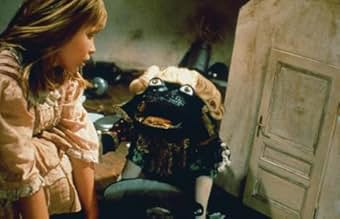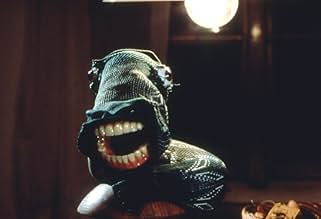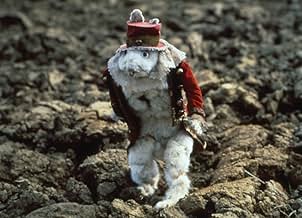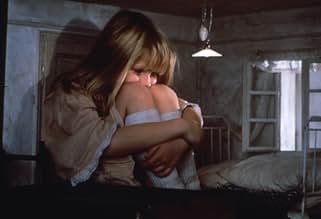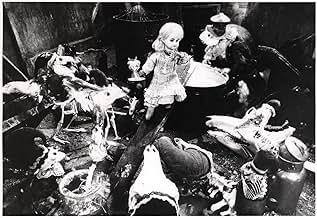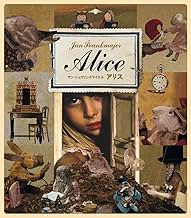A surrealistic revision of Alice in Wonderland.A surrealistic revision of Alice in Wonderland.A surrealistic revision of Alice in Wonderland.
- Director
- Writers
- Stars
- Awards
- 1 win & 1 nomination total
Camilla Power
- Alice
- (English version)
- (voice)
- Director
- Writers
- All cast & crew
- Production, box office & more at IMDbPro
Featured reviews
Wow, an 'Eraserhead' for children. This film has some of the most gorgeous imagery in an animated film that I've seen. I don't remember too much of "Alice in the Wonderland" from the Disney version that I've seen a couple years ago, but I've got a hunch it didn't involve a girl crawling through a drawer after a rabbit with clicking gopher teeth and a limited diet of sawdust that he has a problem containing in his body, only for her to be left in a room that she fills with her own tears while a small rat has a cookout on her head. "Alice" is a re-telling of the popular children's tale, but it's a vivid and imaginative version that has the ability to disturb to the very same effect of the David Lynch film. The stop-motion animation enhances the creepiness of the film where familiar characters are given a Gothic and dark makeover. The story takes place in an old fashioned setting; the walls faded with age and abandonment. I loved the setting of this odd little tale and its very morbid idea of a "wonderland" and its characters including a frog with a very realistic tongue, a "catapiller" that we wouldn't normally think of such, and a moving wad of meat. The resulting film is a stunning achievement. My only somewhat minor qualm, the narration of the main character Alice's lips popping up repetitively throughout the film really started to get grating in the first couple of minutes. However, completely random and unpredictable, "Alice" moves at a somewhat slow pace but develops a level of coherency in the midst of all its strange happenings. The sounds, all though a bit loud, give so much life to the smallest objects. The film effectively evokes the emotions of the human psych that a surrealist film should aim for. And, in the context of a celebrated children's story, it elevates its effect with jarring imagery and sound that make it memorable and an important film in the history of animated film.
We have all be introduced by either the written form or the theatrical form of the story of "Alice in Wonderland". Unfortunately, I feel that most of us have been introduced to this story through the film version instead of the written word. Sad as it may seem, we have all been sucked into either the Disney version, the Care Bear's version, or better yet even the recent made-for-TV version that was on ABC. So, with that being said, we all then know the story of Alice's journey through Wonderland. For all of you who have perhaps missed out on this fabled children's tale, let me recap for you quickly:
White Rabbit, Small and Big, Caterpillar, Tweetlede & Tweetledum, the Walrus, the pig baby, the Queen of Hearts, the Mad Hatter, "Off with their heads!!!", the Cheshire cat, and the Alice dream.
Although that may seem like a jumbled line of words and phrases, that actually accurately sums up the entire plot of the children's story. What surprises me is that over time the film versions of this story have not changed. They have continued to show this innocent child being swept up in this imaginary and beautiful "Neverland" where she finds herself being the center of attention. I am not sure if studios are afraid to topple the Disney version, or if there is no creativity running through the minds of writers to make a fresh new story of this old tale, but something needed to be done. It was a tired story, that needed a modern day face-lift. With this said, let me introduce you to the Czech version of this fairy tale. While I applaud it for taking a much darker twist to this story, I do denounce it's use of stop motion animation to create the impossible.
Lewis Carroll, the author of the story, really intended "Alice in Wonderland" to be a very scary and dark story for children, and until Disney put their hands on it...it was. What Czech director Jan Svankmajer has done brought back the darkness to Alice. Almost taken from a page out the directing book by David Lynch, it abruptly begins with Alice announcing that she is going to watch a movie...this movie to be exact. She then proceed to play in her room. The movie does follow the actual story of Alice, but it takes a nightmarish version of the favorite characters. For example, the White Rabbit constantly looses his stuffing, only to pull his watch out of his stomach to proclaim that "He is very late for a date". He refills himself by eating wood chips that immediately fall back out of him. At the Mad Hatter party, a wind-up March Hare sits during the entire scene and butters watches to make sure that the gears get oiled. The lady who was watching the baby who is actually a pig is portrayed in this film as a frog footman who battles flies with a very lifelike tongue. Even the smallest of characters are evil. There is a scene with a door mouse that crawls up Alice's head when she is sitting in a pool of her own tears, and proceeds to set up camp in her hair.
For children...I think not...original...I think YES! While it even ends the same as the other versions of "Alice", the feeling that it leaves in your mind and stomach afterwards will be remembered further more than the cutesy animated version.
I tried hard to like this movie. It was art, it was foreign, it was from my native country...but I just couldn't connect with the stop-motion animation.
I don't want to stray you the wrong way, if you enjoy this style of animation, then I really recommend this film to you. I guarantee that you will never think of "Alice in Wonderland" in the same way. The symbolism was very strong and very poignant. I enjoyed how the feeling of Wonderland actually being a part of the house. I loved how the director used household items to create this normally "pretty or cuddly" characters. I also enjoyed the darkness to this film. When I think about it, I don't think of "Alice in Wonderland" as a children's story. A young girl follows a rabbit through an uncharted area (not worried that she is not home) and creates havoc all throughout this peaceful town. When she is finally caught, her punishment handed down by the elected Queen is not fulfilled...instead she awakens only to discover that it was a nightmare. I was always curious why there were so many cute characters in a nightmare. I think Svankmajer saw the darkness in the story and brought it out in this version.
Overall, I enjoy seeing another side of a story that our society loves so much. I love seeing artists take a vision that we have all seen before and turn it into their own design. I think this was done with this film. I applaud my Czech friend for all of the work on this film, and I suggest tackling yet another children's classic soon!!
Grade: *** out of *****
White Rabbit, Small and Big, Caterpillar, Tweetlede & Tweetledum, the Walrus, the pig baby, the Queen of Hearts, the Mad Hatter, "Off with their heads!!!", the Cheshire cat, and the Alice dream.
Although that may seem like a jumbled line of words and phrases, that actually accurately sums up the entire plot of the children's story. What surprises me is that over time the film versions of this story have not changed. They have continued to show this innocent child being swept up in this imaginary and beautiful "Neverland" where she finds herself being the center of attention. I am not sure if studios are afraid to topple the Disney version, or if there is no creativity running through the minds of writers to make a fresh new story of this old tale, but something needed to be done. It was a tired story, that needed a modern day face-lift. With this said, let me introduce you to the Czech version of this fairy tale. While I applaud it for taking a much darker twist to this story, I do denounce it's use of stop motion animation to create the impossible.
Lewis Carroll, the author of the story, really intended "Alice in Wonderland" to be a very scary and dark story for children, and until Disney put their hands on it...it was. What Czech director Jan Svankmajer has done brought back the darkness to Alice. Almost taken from a page out the directing book by David Lynch, it abruptly begins with Alice announcing that she is going to watch a movie...this movie to be exact. She then proceed to play in her room. The movie does follow the actual story of Alice, but it takes a nightmarish version of the favorite characters. For example, the White Rabbit constantly looses his stuffing, only to pull his watch out of his stomach to proclaim that "He is very late for a date". He refills himself by eating wood chips that immediately fall back out of him. At the Mad Hatter party, a wind-up March Hare sits during the entire scene and butters watches to make sure that the gears get oiled. The lady who was watching the baby who is actually a pig is portrayed in this film as a frog footman who battles flies with a very lifelike tongue. Even the smallest of characters are evil. There is a scene with a door mouse that crawls up Alice's head when she is sitting in a pool of her own tears, and proceeds to set up camp in her hair.
For children...I think not...original...I think YES! While it even ends the same as the other versions of "Alice", the feeling that it leaves in your mind and stomach afterwards will be remembered further more than the cutesy animated version.
I tried hard to like this movie. It was art, it was foreign, it was from my native country...but I just couldn't connect with the stop-motion animation.
I don't want to stray you the wrong way, if you enjoy this style of animation, then I really recommend this film to you. I guarantee that you will never think of "Alice in Wonderland" in the same way. The symbolism was very strong and very poignant. I enjoyed how the feeling of Wonderland actually being a part of the house. I loved how the director used household items to create this normally "pretty or cuddly" characters. I also enjoyed the darkness to this film. When I think about it, I don't think of "Alice in Wonderland" as a children's story. A young girl follows a rabbit through an uncharted area (not worried that she is not home) and creates havoc all throughout this peaceful town. When she is finally caught, her punishment handed down by the elected Queen is not fulfilled...instead she awakens only to discover that it was a nightmare. I was always curious why there were so many cute characters in a nightmare. I think Svankmajer saw the darkness in the story and brought it out in this version.
Overall, I enjoy seeing another side of a story that our society loves so much. I love seeing artists take a vision that we have all seen before and turn it into their own design. I think this was done with this film. I applaud my Czech friend for all of the work on this film, and I suggest tackling yet another children's classic soon!!
Grade: *** out of *****
The Alice books are one of the two richest works of literature yet produced. Of the best literature, Alice lends itself to cinematic reinterpretation. And this filmmaker has vision.
But Alice is a coherent work, following the 'apprentice' novel and having kabbalistic structure. This film is episodic, each episode conceived as a different world, connected only by doors. The stories establish an abstract world, a world of logic so pure that the weaknesses of logic are apparent. That's only in part attempted here.
Though in Czech, there is some dainty wordplay: Alice is messing about in her drawers. Initially, these contain drawing equipment, later scissors. The filmmakers' signature 'large person in small room' image is used here in the episode where 'Maryanne' (Alice plus her 'house) is attempted entry by Bill the lizard, Dodgson's image of sperm. Bill is mirrored later in the frog-footman, heavily phallic as is an introduced sequence where the feet themselves become penile, then advisory.
Svenkmajer understands the cards as Tarot, a seldom understood insight and adds a vignette of the March Hare and Hatter playing cards (almost certainly a nod to 'Seventh Seal'). There's some very good visual handling of inside/outside ambiguities, and stage/reality shifting -- this alone makes this project worth sharing. But aside from that, it seems that the magic of Alice's world has yet to be tapped by a filmmaker.
Note: in Carroll's vision, innocence trumps all: logic is seen as manmade and fallible. In this world confabulated reasoning threatens but no one really loses their head. Not so in Svenkmajer's bleak world. Heads really are lost. Innocence is at least dumbfounded and possibly unreal (those socks). Many heads are already decayed with only the skull remaining. Some beings are composed of empty skulls alone or with some ambulatory object. This is not a happy man, nor a world with any sunshine. I would not give these images to any child.
But Alice is a coherent work, following the 'apprentice' novel and having kabbalistic structure. This film is episodic, each episode conceived as a different world, connected only by doors. The stories establish an abstract world, a world of logic so pure that the weaknesses of logic are apparent. That's only in part attempted here.
Though in Czech, there is some dainty wordplay: Alice is messing about in her drawers. Initially, these contain drawing equipment, later scissors. The filmmakers' signature 'large person in small room' image is used here in the episode where 'Maryanne' (Alice plus her 'house) is attempted entry by Bill the lizard, Dodgson's image of sperm. Bill is mirrored later in the frog-footman, heavily phallic as is an introduced sequence where the feet themselves become penile, then advisory.
Svenkmajer understands the cards as Tarot, a seldom understood insight and adds a vignette of the March Hare and Hatter playing cards (almost certainly a nod to 'Seventh Seal'). There's some very good visual handling of inside/outside ambiguities, and stage/reality shifting -- this alone makes this project worth sharing. But aside from that, it seems that the magic of Alice's world has yet to be tapped by a filmmaker.
Note: in Carroll's vision, innocence trumps all: logic is seen as manmade and fallible. In this world confabulated reasoning threatens but no one really loses their head. Not so in Svenkmajer's bleak world. Heads really are lost. Innocence is at least dumbfounded and possibly unreal (those socks). Many heads are already decayed with only the skull remaining. Some beings are composed of empty skulls alone or with some ambulatory object. This is not a happy man, nor a world with any sunshine. I would not give these images to any child.
Animation legend Jan Svankmajer applies his distinctive style to Lewis Carroll's most famous creation, crafting one of the most original and unforgettable takes on Alice's adventures ever put to film. Having previously adapted Carroll in his 1971 short film, "Jabberwocky," Svankmajer returns to the author's work with this amazing feature-length film. Employing a magnificent blend of live action and stop-motion animation, he uses many of Carroll's ideas as jumping-off points. Many of the characters are reconstructed as nightmarish abstracts of the way they have usually been depicted in previous adaptions. The white rabbit is a stuffed real rabbit who keeps his watch tucked in a sawdust-leaking gap in his chest. The Dormouse has been reduced to a creepy crawling foxlike hide, and the Caterpillar is a sock with eyeballs and teeth that sews its eyes shut when it sleeps. Although familiar characters such as the Mock Turtle and the Cheshire Cat are left out, Svankmajer's film is incredibly faithful to the book's sense of fantasy and absurdity. The minimal dialogue and pronounced sound effects also add to the overall unsettling mood. The key to truly appreciating this version is to forget the common associated imagery from other adaptions, and treat this as its own entity. Just as a dream makes a totally different impression on you than a person you describe it to (regardless of how well you describe it), this film is one man's surreal interpretation of another man's surreal description. The skull-headed birds, walking dolls, and broken-down furniture of Svankmajer's world make this a pretty disturbing telling of Alice's journey, but a masterful, enthralling, and undeniably unique one as well.
Watched this last night - one of my favorites, especially as and ex-art student. He animated everything from socks to lumps of meat. Very dark, and would have been darker yet without the little girls voice over. My favorite scene, I think, is when the water rat sets up camp on her head. There is a lot to watch out for in this film, a hundred little touches, and references. Follows the book to a certain extent, but goes its own lunatic-asylum way. If you have very vivid dreams and wake up in the morning wondering 'what the heck was that all about?', it is a bit like watching this film:)
Did you know
- TriviaDirector Jan Svankmajer had been disappointed by other adaptations of Carroll's book, which interpret it as a fairy tale. His aim was instead to make the story play out like an amoral dream.
- GoofsAfter testing the wooden mushroom fragments, Alice puts the piece that shrinks things in her right pocket and the other that enlarges things in the left one. In the next scene she encounters a tiny house and takes out the right hand fragment to enlarge it.
- ConnectionsFeatured in Brows Held High: Alice (2011)
- How long is Alice?Powered by Alexa
Details
- Runtime1 hour 26 minutes
- Sound mix
- Aspect ratio
- 1.37 : 1
Contribute to this page
Suggest an edit or add missing content


